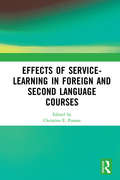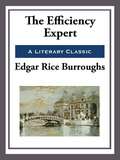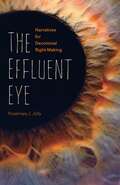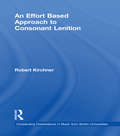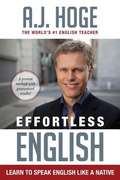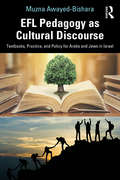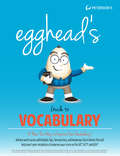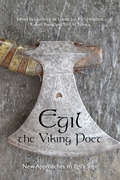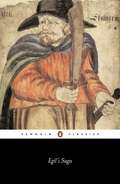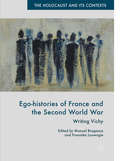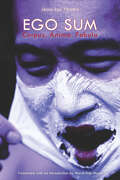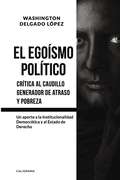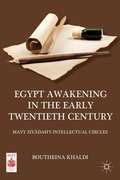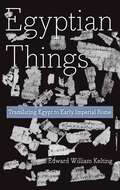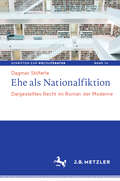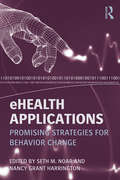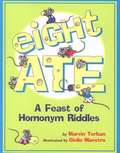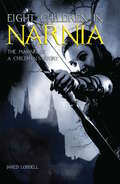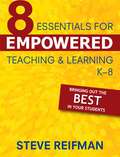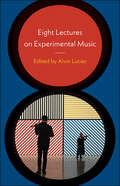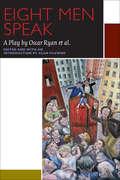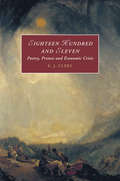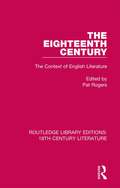- Table View
- List View
Effects of Service-Learning in Foreign and Second Language Courses
by Christine E. PoteauThis edited volume brings together several original studies that critically examine the quantitative and qualitative effects of service-learning (SL) on foreign and second language learning, and its impact on communities, learners, pre-service teacher candidates, and faculty-researchers. The book focuses on two key aspects: Innovative SL methodologies that seek to develop linguistic and cultural competencies and empirical investigations on the SL effects on all stakeholders. The analysis presented provides a unique insight into the challenges and future directions of SL research, pedagogical assessment, and community impact.
The Efficiency Expert
by Edgar Rice BurroughsThis anthology is a thorough introduction to classic literature for those who have not yet experienced these literary masterworks. For those who have known and loved these works in the past, this is an invitation to reunite with old friends in a fresh new format. From Shakespeare s finesse to Oscar Wilde s wit, this unique collection brings together works as diverse and influential as The Pilgrim s Progress and Othello. As an anthology that invites readers to immerse themselves in the masterpieces of the literary giants, it is must-have addition to any library.
The Effluent Eye: Narratives for Decolonial Right-Making
by Rosemary J. JollyWhy human rights don&’t work In The Effluent Eye, Rosemary J. Jolly argues for the decolonization of human rights, attributing their failure not simply to state and institutional malfeasance but to the very concept of human rights as anthropocentric—and, therefore, fatally shortsighted. In an engaging mix of literary and cultural criticism, Indigenous and Black critique, and substantive forays into the medical humanities, Jolly proposes right-making in the demise of human rights. Using what she calls an &“effluent eye,&” Jolly draws on &“Fifth Wave&” structural public health to confront the concept of human rights—one of the most powerful and widely entrenched liberal ideas. She builds on Indigenous sovereignty work from authors such as Robin Wall Kimmerer, Leanne Betasamosake Simpson, and Mark Rifkin as well as the littoral development in Black studies from Christine Sharpe, Saidiya Hartman, and Tiffany Lethabo King to engage decolonial thinking on a range of urgent topics such as pandemic history and grief; gender-based violence and sexual assault; and the connections between colonial capitalism and substance abuse, the Anthropocene, and climate change. Combining witnessed experience with an array of decolonial texts, Jolly argues for an effluent form of reading that begins with the understanding that the granting of &“rights&” to individuals is meaningless in a world compromised by pollution, poverty, and successive pandemics. Retail e-book files for this title are screen-reader friendly.
An Effort Based Approach to Consonant Lenition (Outstanding Dissertations in Linguistics)
by Robert KirchnerThe first serious typological survey of the lenition process in modern phonological literature.
Effortless English: Learn to Speak English Like a Native
by A. J. HogeLearn To Speak English Like A NativeA. J. HOGE, THE WORLD'S #1 ENGLISH TEACHER, teaches you his most powerful methods for learning to speak English fluently and confidently. Famous for training corporate and government leaders, A. J. Hoge gives you a step by step program teaching you the system that will help you achieve ultimate success with English. Effortless English will. . . . . * Teach you how to overcome nervousness, shyness, and fear when speaking English. * Show you how to achieve a high TOEFL, IELTS, or TOEIC score. * Help you learn vocabulary 4-5 times faster. * Tell you how to feel stronger, calmer, and more powerful when speaking English. * Teach you how to understand native speakers and communicate clearly with them. * Help you get better jobs using English. "You have studied English many years, yet you still do not speak well. You read English but you feel nervous and frustrated when speaking. It is time for a change. I will teach you to speak English quickly, easily, and automatically using my Effortless English System (TM). You can achieve success now simply by changing the way you learn English. "-- A. J. Hoge
EFL Pedagogy as Cultural Discourse: Textbooks, Practice, and Policy for Arabs and Jews in Israel
by Muzna Awayed-BisharaThis book offers unique insight into the role that English as a Foreign Language (EFL) discourse plays in shaping the ideological terrain of contemporary Israel/Palestine through constructing the subjectivities of those who plan, teach, and learn it. While the EFL curriculum is uniform across Hebrew and Arabic-speaking educational contexts, this book traces how its cultural content reproduces dominant hegemonic ideologies, and perpetuates the social misrepresentations of the Other that underlie inequality. The language of English teaching textbooks, the way that students understand their content, and the official policy documents that guide both EFL materials and teaching practices, are all thoroughly examined through Critical Discourse Analysis. The theoretical and methodological foundation for further cross-cultural studies of Anglo-centric and other forms of hegemonic EFL discourses within local/global contexts, and for contesting their ideological effects, are also laid down. Through promoting a transformative EFL cultural discourse which hopes to position EFL teaching as a possible arena for effecting social change, this book offers a unique context for students, scholars, and educators interested in linguistics, CDA, cultural discourse studies, English in local/global contexts, and EFL education.
Egghead's Guide to Vocabulary
by Peterson'sPeterson's egghead's Guide to Vocabulary will help students improve the range of their vocabulary, boost their scores on verbal ability tests, and improve their diction on any writing assignment. With the help of Peterson's new character, egghead, students can strengthen their vocabulary with narrative cartoons and graphics. Along the way there are plenty of verbal lessons and exercises, making this the perfect guide for students struggling to develop their vocabulary. egghead's tips and advice for improving vocabulary skills Hundreds of vocabulary words students can use to help improve their verbal scores on standardized tests Dozens of vocabulary-building exercises with plenty of examples of words usage Easy-to-read lessons with fun graphics that provide essential information to help those students who learn visually
Egil, the Viking Poet
by Russell Poole Laurence De Looze Jon Karl Helgason Torfi H. TuliniusEgil, the Viking Poet focuses on one of the best-known Icelandic sagas, that of the extraordinary hero Egil Skallagrimsson. Descended from a lineage of trolls, shape-shifters, and warriors, Egil's transformation from a precocious and murderous child into a raider, mercenary, litigant, landholder, and poet epitomizes the many facets of Viking legend.The contributors to this collection of essays approach Egil's story from a variety of perspectives, including psychology, philology, network theory, social history, and literary theory. Strikingly original, their essays will appeal not only to dedicated students of Old Norse-Icelandic literature but also to those working in the fields of Viking studies, comparative ethnology, and folklore.
Egil's Saga
by Leifur EirikssonEgil's Saga tells the story of the long and brutal life of tenth-century warrior-poet and farmer Egil Skallagrimsson: a morally ambiguous character who was at once the composer of intricately beautiful poetry, and a physical grotesque capable of staggering brutality. The saga recounts Egil's progression from youthful savagery to mature wisdom as he struggles to avenge his father's exile from Norway, defend his honour against the Norwegian King Erik Bloodaxe, and fight for the English King Athelstan in his battles against Scotland. Exploring issues as diverse as the question of loyalty, the power of poetry, and the relationship between two brothers who love the same woman, Egil's Saga is a fascinating depiction of a deeply human character.
Ego-histories of France and the Second World War: Writing Vichy (The\holocaust And Its Contexts Ser.)
by Manuel Bragança Fransiska LouwagieThis volume presents the intellectual autobiographies of fourteen leading scholars in the fields of history, literature, film and cultural studies who have dedicated a considerable part of their career to researching the history and memories of France during the Second World War. Basedin five different countries, Margaret Atack, Marc Dambre, Laurent Douzou, Hilary Footitt, Robert Gildea, Richard J. Golsan, Bertram M. Gordon, Christopher Lloyd, Colin Nettelbeck, Denis Peschanski, Renée Poznanski, Henry Rousso, Peter Tame, and Susan Rubin Suleiman have playeda crucial role in shaping and reshaping what has become a thought-provoking field of research. This volume, which also includes an interview with historian Robert O. Paxton, clarifies the rationales and driving forces behind their work and thus behind our current understanding of one of the darkest and most vividly remembered pages of history in contemporary France.
Ego Sum: Corpus, Anima, Fabula
by Jean-Luc NancyFirst published in 1979 but never available in English until now, Ego Sum challenges, through a careful and unprecedented reading of Descartes’s writings, the picture of Descartes as the father of modern philosophy: the thinker who founded the edifice of knowledge on the absolute self-certainty of a Subject fully transparent to itself. While other theoretical discourses, such as psychoanalysis, have also attempted to subvert this Subject, Nancy shows how they always inadvertently reconstituted the Subject they were trying to leave behind.Nancy’s wager is that, at the moment of modern subjectivity’s founding, a foundation that always already included all the possibilities of its own exhaustion, another thought of “the subject” is possible. By paying attention to the mode of presentation of Descartes’s subject, to the masks, portraits, feints, and fables thatpopulate his writings, Jean-Luc Nancy shows how Descartes’s ego is not the Subject of metaphysics but a mouth that spaces itself out and distinguishes itself.
El egoísmo político: Crítica al caudillo generador de atraso y pobreza
by Washington Delgado LópezUn aporte a la Institucionalidad Democrática y al Estado de Derecho. El aporte a la institucionalidad democrática de El egoísmo político. <P><P>Crítica al caudillo, generador de atraso y pobreza es una denuncia al intervencionismo, autoritarismo y totalitarismo que a través del ejercicio del vicio político anula al individuo y a la comunidad para el desarrollo en los países pobres, haciendo estériles las soluciones que en otros países dan resultados. <P><P>En Latinoamérica, el egoísmo político se matiza con el populismo, nacionalismo y otros ismos que se convierten en caldo de cultivo para la corrupción y la ineficiencia administrativa del Estado al apoderarse y perennizarse en el poder. A la vez, es una invitación a los líderes virtuosos de la política para que abandonen la permisividad, la indiferencia y el silencio en el combate al caudillo.
Egypt Awakening in the Early Twentieth Century
by Boutheina KhaldiThrough a detailed study of Mayy Ziy?dah's literary salon, Boutheina Khaldi sheds light on salon and epistolary culture in early twentieth-century Egypt and its role in Egypt's Nahdah (Awakening). Bringing together history, women's studies, Arabic literature, post-colonial literature, and media studies, she highlights the important and previously little-discussed contribution of Arabic women to the project of modernity.
Egyptian Colloquial Poetry in the Modern Arabic Canon
by Noha M. RadwanNoha Radwan offers the first book-length study of the emergence, context, and development of modern Egyptian colloquial poetry, recently used as a vehicle for communications in the revolutionary youth movement in Egypt on January 25th 2011, and situates it among modernist Arab poetry.
Egyptian Things: Translating Egypt to Early Imperial Rome
by Edward William KeltingA free ebook version of this title is available through Luminos, University of California Press’s Open Access publishing program. Visit www.luminosoa.org to learn more. After the deaths of Antony and Cleopatra, Rome finally took control of Egypt. This occupation simultaneously facilitated and circumscribed the exchange of goods, people, and ideas along the paths carved across Rome’s burgeoning empire. In this book, Edward Kelting sets out to recapture one of these systems of exchange: the vibrant literary tradition known as Aegyptiaca—or "Egyptian things"—in which culturally mixed authors wrote about Egypt for a Greek and Roman audience. These authors have been dismissed as not really "Egyptian," and their contemporary popularity has been ignored. But as Kelting powerfully argues, this genre in fact constitutes a vibrant intellectual tradition, developed from heterogeneous influences but deeply engaged with Egypt’s pharaonic past. In contrast to usual narratives of Roman domination, Kelting uncovers a complex project of political engagement and cultural translation in which Egyptians, Greeks, and Romans all participated.
Ehe als Nationalfiktion: Dargestelltes Recht im Roman der Moderne (Schriften zur Weltliteratur/Studies on World Literature #10)
by Dagmar StöferleEs gibt eine Vorgeschichte des Ehebruchromans, der in der zweiten Hälfte des 19. Jahrhunderts zu einem gesamteuropäischen literarischen Paradigma wurde. Im Zuge der Französischen Revolution entsteht eine säkulare Ehegesetzgebung, die einen metaphorischen Überschuss produziert, der bis heute wirksam ist. Das Buch zeichnet rechtshistorisch und anhand kanonischer literarischer Texte von Rousseau über Goethe und Manzoni bis hin zu Hugo und Flaubert nach, wie die Ehe um 1800 zu einer Reflexionsfigur für den modernen Nationalstaat werden konnte. Dabei entstehen originelle Beiträge zur Philologie der einzelnen Texte. Zugleich werden Recht und Literatur für eine historische Semantik von Gesellschaft und Gemeinschaft fruchtbar gemacht.
eHealth Applications: Promising Strategies for Behavior Change (Routledge Communication Series)
by Seth M. Noar Nancy Grant HarringtoneHealth Applications: Promising Strategies for Behavior Change provides an overview of technological applications in contemporary health communication research, exploring the history and current uses of eHealth applications in disease prevention and management. This volume focuses on the use of these technology-based interventions for public health promotion and explores the rapid growth of an innovative interdisciplinary field. The chapters in this work discuss key eHealth applications by presenting research examining a variety of technology-based applications. Authors Seth M. Noar and Nancy Grant Harrington summarize the latest in eHealth research, including a range of computer, Internet, and mobile applications, and offer observations and reflections on this growing area, such as dissemination of programs and future directions for the study of interactive health communication and eHealth. Providing a timely and comprehensive review of current tools for health communication, eHealth Applications is a must-read for scholars, students, and researchers in health communication, public health, and health education.
Eight Ate
by Marvin TerbanThis collection of original riddles is unlike any other because the main words in each answer sound exactly alike, but have different meanings. Zany illustrations add to the fun and provide clues to the solutions. And the newly designed full-color cover makes the package even more appealing. So dig in--and see why you should play with your words (not with your food)!
Eight Children in Narnia: The Making of a Children's Story
by Jared LobdellEight Children in Narnia is a detailed study of C.S. Lewis's Chronicles of Narnia, exploring the story's influences, themes, symbols, ironies-and the reasons for its enormous popular success. Lobdell draws attention to insistent motifs in the work: the great house in the country, the past alive in the present, the life of the imagination, the mixture of the familiar and the adventurously new, the combination of pageant and satire, the child as judge, and the child as warrior. A prolific writer and literary scholar with an established reputation, Lewis decided quite late in life to write something completely new to him: a story for children, and he drew upon his own childhood memories as well as his literary and philosophical theories. Among the many important influences Lobdell identifies Bunyan, Swift, Kipling, and the popular children's writer E. Nesbit, as well as the classic fairy-tale and medieval romance.
Eight Essentials for Empowered Teaching and Learning, K-8: Bringing Out the Best in Your Students
by Steve ReifmanInspirational and practical, this book focuses on the quality of teaching and learning in elementary and middle school classrooms and helps teachers and students find more joy, satisfaction, and meaning in their work.Experienced teacher Steve Reifman defines a quality classroom in reader-friendly terms, explains how to measure quality, and covers the conditions under which all students are empowered to reach their full potential. The author synthesizes key concepts from the fields of education, psychology, management, and personal growth to arrive at the eight essential elements of teaching, including realistic goal setting, assessment-oriented instruction, parent involvement, and teacher leadership. Written in an engaging personal voice and drawing upon the work of experts such as Stephen Covey, Howard Gardner, Ted Sizer, William Glasser, Carol Ann Tomlinson, Alfie Kohn, and Alan Blakenstein, this resourcePromotes student motivation and a classroom environment of trust and respectBuild higher-level thinking and group problem solving into the curriculumPresents classroom applications, examples, anecdotes, and reproducible pagesFeatures ideas from practicing teaching for putting these essential ideas to work in the classroomEight Essentials for Empowered Teaching and Learning, K-8 motivates student teachers, beginning teachers, and veteran educators to become the most effective instructors they can be and achieve the best learning outcomes possible for their students.
Eight Great American Short Novels
by Philip RahvThe Man Who Became a Woman by Sherwood Anderson; The Blue Hotel by Stephen Crane; Red Leaves by William Faulkner; An International Episode by Henry James; Bartleby the Scrivener by Herman Melville; Wise Blood by Flannery O'Connor; The Long March by William Styron; False Dawn by Edith Wharton
Eight Lectures on Experimental Music
by Alvin LucierBrilliant lectures by the most influential experimental music composers of our time In this brilliant collection, path-breaking figures of American experimental music discuss the meaning of their work at the turn of the twenty-first century. Presented between 1989 and 2002 at Wesleyan University, these captivating lectures provide rare insights by composers whose work has shaped our understanding of what it means to be experimental: Maryanne Amacher, Robert Ashley, Philip Glass, Meredith Monk, Steve Reich, James Tenney, Christian Wolff, and La Monte Young. Collected here for the first time, together these lectures tell the story of twentieth-century American experimental music, covering such topics as repetition, phase, drone, duration, collaboration, and technological innovation. Containing introductory comments by Lucier and the original question and answer sessions between the students and the composers, this book makes the theory and practice of experimental music available and accessible to a new generation of students, artists, and scholars.
Eight Men Speak: A Play by Oscar Ryan et al. (Canadian Literature Collection)
by Oscar Ryan Edward Cecil-Smith Frank Love Mildred GoldbergThis volume comprises a reprinting and gloss of the original text of the 1933 Communist play Eight Men Speak. The play was banned by the Toronto police after its first performance, banned by the Winnipeg police shortly thereafter and subsequently banned by the Canadian Post Office. The play can be considered as one stage–the published text–of a meta-text that culminated in 1934 at Maple Leaf Gardens when the (then illegal) Communist Party of Canada celebrated the release of its leader, Tim Buck, from prison. Eight Men Speak had been written and staged on behalf of the campaign to free Buck by the Canadian Labour Defence League, the public advocacy group of the CPC. In its theatrical techniques, incorporating avant-garde expressionist staging, mass chant, agitprop and modernist dramaturgy, Eight Men Speak exemplified the vanguardist aesthetics of the Communist left in the years before the Popular Front. It is the first instance of the collective theatrical techniques that would become widespread in subsequent decades and formative in the development of modern Canadian drama. These include a decentred narrative, collaborative authorship and a refusal of dramaturgical linearity in favour of theatricalist demonstration. As such it is one of the most significant Canadian plays of the first half of the century, and, on the evidence of the surviving photograph of the mise-en-scene, one of the earliest examples of modernist staging in Canada. - This book is published in English.
Eighteen Hundred and Eleven: Poetry, Protest and Economic Crisis (Cambridge Studies in Romanticism #116)
by E. J. CleryIn 1811 England was on the brink of economic collapse and revolution. The veteran poet and campaigner Anna Letitia Barbauld published a prophecy of the British nation reduced to ruins by its refusal to end the interminable war with France, titled Eighteen Hundred and Eleven. Combining ground-breaking historical research with incisive textual analysis, this new study dispels the myth surrounding the hostile reception of the poem and takes a striking episode in Romantic-era culture as the basis for exploring poetry as a medium of political protest. Clery examines the issues at stake, from the nature of patriotism to the threat to public credit, and throws new light on the views and activities of a wide range of writers, including radical, loyalist and dissenting journalists, Coleridge, Wordsworth, Southey, and Barbauld herself. Putting a woman writer at the centre of the enquiry opens up a revised perspective on the politics of Romanticism.
The Eighteenth Century: The Context of English Literature (Routledge Library Editions: 18th Century Literature)
by Pat RogersThe aim of this book, originally published in 1978, is to make the reading of literary classics such as Gulliver’s Travels, Robinson Crusoe, Tom Jones, The Beggar’s Opera and Tristram Shandy an even richer experience by giving them an intelligible place in history. The ‘context’ is seen not as a vague backcloth, but as a living fabric of ideas and events which animate Augustan literature. The authors cover the achievements of men like Hume, Walpole, Chippendale, Newton and Reynolds, who are often merely names to the literary student, and show how writers were affected by exciting developments in psychology, aesthetics, medicine and other fields. As a whole the book shows this period to have been an active, questing and complex era, whose literary masterpieces emanate from a rich and diverse culture.
